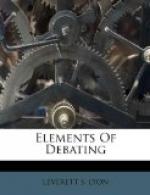(6) Henry Hawkins, a student
at the Johnstown High School, asserts
that they have the best football
team in the state.
(7) M. Metchnikoff, chief attendant at the Pasteur Institute, says: “As for myself, I am convinced that alcohol is a poison.” M. Berthelot, member of the Academy of Science and Medicine, states: “Alcohol is not a food, even though it may be a fuel.”
(8) Lord Chatham, a member
of the English Parliament, said, in
speaking of the Revolutionary
War: “It is a struggle of free and
virtuous patriots.”
6. On the basis of your answers to 5, state three conditions that would make a man’s speaking or writing weak evidence as testimony; three that would make a man’s testimony strong.
7. In Exercise 5 is (3), (4), or (5) the strongest testimony in favor of labor unions. Why? Which is next?
8. Can you see one danger of relying on testimony alone for evidence?
LESSON VI
THE BRIEF. THE CHOICE AND USE OF EVIDENCE
I. What the brief is.
II. What the brief does.
III. Parts of the brief:
1. The introduction in which—
(1) The end desired is made clear.
(2) The issues are determined.
2. The proof, which states the issues as facts and proves them.
3. The conclusion, which is a formal summary of the proof.
IV. A specimen model brief.
V. A specimen special brief.
VI. Rules for briefing.
When a builder begins the construction of a wall, he must have the proper material at hand. When an engineer begins the construction of a steel bridge, he must have metal of the right forms and shapes. Neither of these men, however, can accomplish the end which he has in mind unless he takes this material and puts it together in the proper way. So it is with the debater. He may have plenty of good evidence, but he will never win unless that evidence is organized, that is, put together in the most effective manner.
The builder, if he were building a wall of concrete, would get the correct form by pouring the concrete into a mold. So also, there is a mold which the debater should use in shaping his evidence. When the evidence has been put into this form, the debater is said to have constructed a brief.
In a previous lesson we saw how we might prove that John Quinn was a dangerous man by using the evidence of a court record. If we had put that evidence in brief-form we should have had this:
John Quinn was a dangerous man, for:
1. He was a thief, for:
(1) The Illinois state courts
found him guilty of robbing a bank,
for:
a) See Ill. Court Reports, Vol. X., p. 83.
The brief, then, is a concise, logical outline of everything that the speaker wishes to say to the audience.




